

Tree of Life Images
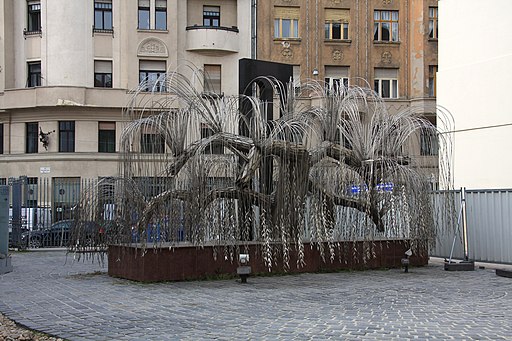
Jewish Tree of Life at Budapest Synagog
The baobab, also known as "the Tree of Life" for its vitality and longevity, grows in African and Indian savannas. Its height can reach up to 25 meters. Baobabs can live for several thousand years. This tree remains leafless for nine months of the year. Some people describe it like a tree that has been picked out of the ground and stuffed back in upside-down. The secret of the baobab's surviving in harsh environments is that it has little wood fibre but a large water storage capacity. It is able to hold up to 300 litres of water. In the wet months water is stored in its thick, corky, fire-resistant trunk for the nine dry months ahead. They produce leaves for only a short time during the rainy season, when they also develop huge pink or white flowers. The trees are pollinated by bats and have a fruit as unique as the tree itself. It has a furry coating around a tough, gourd-like shell that shields a soft pulp inside called 'monkey bread' and seeds that are rich in citric acid and oil

Jewish Tree of Life at Budapest Synagog (2)

Centrum securitatis 'Tree of Life'
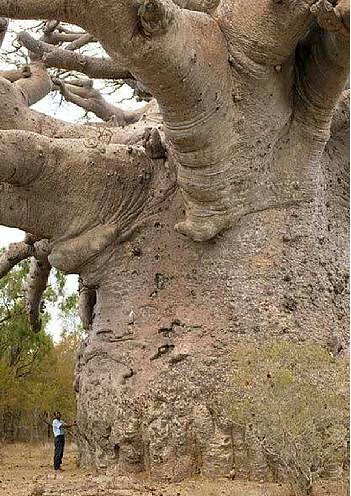
The baobab, also known as "the Tree of Life" for its vitality and longevity, grows in African and Indian savannas. Its height can reach up to 25 meters. Baobabs can live for several thousand years. This tree remains leafless for nine months of the year. Some people describe it like a tree that has been picked out of the ground and stuffed back in upside-down. The secret of the baobab's surviving in harsh environments is that it has little wood fibre but a large water storage capacity. It is able to hold up to 300 litres of water. In the wet months water is stored in its thick, corky, fire-resistant trunk for the nine dry months ahead. They produce leaves for only a short time during the rainy season, when they also develop huge pink or white flowers. The trees are pollinated by bats and have a fruit as unique as the tree itself. It has a furry coating around a tough, gourd-like shell that shields a soft pulp inside called 'monkey bread' and seeds that are rich in citric acid and oil
Tree of Life Images
From Wikipedia, the free encyclopedia - The following description of the 'Tree of Life Meaning' is an extract from Wiki and is reprinted under Creative Commons'.Category:Tree of life
Subcategories
This category has the following 9 subcategories, out of 9 total.
B
C
K
P
T
Media in category "Tree of life"
The following 19 files are in this category, out of 19 total.
-
AfrTryp LifeCycle cs.png
127 KB -
Chay18.jpg
9 KB -
Missing link hominid.png
17 KB -
Road to Karpata (339370168).jpg
1.16 MB -
Teppich-Museum Oelsnitz 05.jpg
4.53 MB -
Tree of life.jpg
9.67 MB
----------------------------------------
Tree of Life (craft)
From Wikipedia, the free encyclopedia- Text is available under the Creative Commons Attribution-ShareAlike License;
A Tree of Life (Spanish: Árbol de la vida) is a theme of clay sculpture created in central Mexico,
especially in the municipality of Metepec, State of Mexico. The image depicted in these sculptures originally was for the teaching
of the Biblical story of creation to natives in the early colonial period. The fashioning of the trees in a
clay sculpture began in Izúcar de Matamoros, Puebla but today the craft is most closely identified with Metepec.[1] Traditionally, these sculptures are supposed to
consist of certain biblical images, such as Adam and Eve, but recently there have been trees created with themes completely
unrelated to the Bible.[2]
Origins of the craft
The creation of Trees of Life is part of the pottery and ceramic traditions of
central highlands of Mexico. Pottery in this area can be traced back to between 1800 and 1300 B.C. including
clay figures. The painting of these figures begins later after Olmec influence arrived in the area. Around 800 A.D. Teotihuacan influence brought religious symbolism to many ceramic wares. From then on,
Matlatzinca pottery in what is now Mexico State continued to develop with multiple influences since it was
in a strategic position between the Valley of Mexico and what are now the states of Morelos and
Guerrero.[1]
After the Spanish conquest, friars destroyed articles, including ceramics, that depicted the old
gods, and replaced them with images of saints and other Christian iconography. The depiction of a “tree of
life” in paintings and other mediums was introduced as a way to evangelize Biblical stories to the native
population.[1]
During most of the colonial period, ceramics in Mexico State were mostly produced for
self consumption. Ceramics became a fusion of Spanish and indigenous techniques and designs. It remained so
until the first half of the 20th century, when decorative and even luxurious pieces began to be produced.
This type of work is typified by the tree of life, especially those that are not religious in function.
These non-religious trees have themes such as death or spring.[3]
The construction of clay tree sculptures with the Biblical theme of the Garden of
Eden began in Izucar de Matamoros in Puebla State and spread to other areas, particularly to Metepec, Mexico
State, which distinguished their trees by painting them in bright colors.[3][4] The tree sculptures have become emblematic of this
municipality, and are part of a clay sculpture tradition found only here.[2] Other common clay sculptures include mermaids (with
a giant one in a section of town called Ciudad Tipica) as well as Pegasus, roosters, lions, flowers and more.[3]
The most traditional of the trees of life contains a number of vital images. At the
top of the sculpture, an image of God is placed. Underneath are images relation with the creation of the
world in seven days, such as the sun and moon, the animals and Adam and Eve. The serpent from the Biblical
story also appears, as does the Archangel Gabriel at the bottom, who casts out Adam and Eve from the Garden of Eden.[1] Overall, the tree sculpture looks something like a
candelabra.[5] The trees are made primarily for religious and
decorative use. Those that contain incense burners are more likely to be use religiously. In Izucar de
Matamoros, these trees appear in processions such as those for Corpus Christi.[6]
The trees are made from clay fired in gas ovens at a low temperature.[5][7] Most trees are from between 26 to 60 cm in
height and can take anywhere from two weeks to three months to create.[1][2] Extremely large pieces can take up to three years.
These trees vary in size from miniatures to gigantic public sculptures.[7] Many trees have unique themes but the most common is
the duality of life and death and the relationship of man with the natural world. Most trees are created and
sold by artisans who have learned how to make them from their parents and grandparents.[7]
Variations on the craft have appeared in recent decades. Many will have themes such
as the duality of life and death, and the relationship of man with the natural world, but these often keep
essential elements such as Adam and Eve.[7] Tiburcio Soteno Fernandez is one of the few potters who will make arboles with themes
completely unrelated to the Garden of Eden. Many of these represent the history of a famous person or place
and are custom-ordered. His works have appeared in temporary and permanent collections in countries such as
Scotland, the United States, Canada, Italy and France.[2] However, purists insist that those that do not
relate to the Garden of Eden are not true Trees of Life.[6]
A tree of life sculpture appears on the cover of the Sgt. Pepper's Lonely Hearts Club Band album by The Beatles.[5]
State of the craft
The craft is made in three principal areas: Metepec, Mexico State, Izucar de
Matamoros, and Acatlan, both in Puebla, and most are made with commercial intent. In the old days,
these were a traditional gift for newlyweds as a symbol of fertility and abundance.[6]
The craft is best preserved in Metepec, where craftsmen have received orders from countries such as China,
Japan, France, Italy and Germany with a large number going to Spain.[7]
The best known potters in Metepec include Archundia, Tito Reyes, Modesta Fernandez, Macario Garduno, Paz
Lopez, Claudio Tapia, Timoteo Gonzalez, Celso Rodriguez, Jose Sanchez de Leon, Lazaro and Manuel
Leon.[3]
The government of the municipality of Metepec has sponsored courses in pottery and ceramics to keep the
tradition alive.[8]
However, the craft has been waning and may be in danger of extinction. On Comonfort
Street in Metepec there are dozens of pottery workshops but only two of these remain making the
trees.[5]
One major reason for this is cheap imitations, mostly imported from Asia. This has been a problem for many
Mexican crafts, with the federal government stepping in to develop trademarks and “denomination of origin”
for traditional crafts. In 2009, the Tree of Life was trademarked for artisans from Metepec and
neighboring Calimaya, befitting the approximately 300 families that dedicate themselves to making
them. In addition to authenticity, there are plans to use the trademark to promote the product
internationally.[9][10]
There is a national ceramics prize called the Concurso Nacional de Alfareria y
Ceramica “Arbol de la Vida” presented each year by the municipality but entrants are not limited to trees of
life. Pieces from various places in Mexico, such as Oaxaca, Jalisco and Guanajuato but most pieces are from Mexico State. There are categories for unfired
pieces, pieces fired at low temperatures, pieces fired at high temperatures and glazed pieces.[11]
Each year representatives from the various indigenous communities of Mexico gather to form a human “Tree
of Life.” In 2006, 500 people from 63 different ethnic groups came to make the human pyramid, dress in
native wear and calling for peace in the world. Some of the peoples represented include Zapotecs, Huastecs, P'urhépecha, Maya, Otomi, Tarahumara Huicholes and Yaquis.[4]
However, other projects with similar ambitions, such as the Explanada Artesanal, have
not experience much success. The Explanada is dirty, lacks lighting and lacks visitors despite the authentic
wares sold here. It is located on Hidalgo Street in Metepec with 95 stands that sell clay and ceramic crafts
made in the municipality. Because of the lack of visitors, many of these stands are only open on the
weekends. Vendors state that the problem is that the municipality does not support the park, by not
providing services and by not promoting it.[8]
Text is available under the Creative Commons Attribution-ShareAlike License;
The Mexican Tree of Life
Mexican Tree of Life is the name given to a hand coiled pottery sculpture depicting
the biblical Tree of Life; traditionally the tree sculpture would include Adam and Eve with the tempting
Serpent but the themes have evolved and today is common to find trees about various subjects such as Day of
the Dead and Folk Art.
OriginThe decorative clay pieces known as Arboles de la Vida developed from the ceremonial candelabra and incense burners made by crafters from Izucar de Matamoros a town in Puebla State. The design was probably taken from the bronze and silver pieces brought by the friars to use in the church.
As time went by the clay replicas became colorful and intricately decorated pieces
with flowers, leaves and animals on their branches; Adam, Eve and the Serpent on their main trunk and the
Archangel Gabriel at their base.

Tree of Life by Aurelio Flores
The first potter to develop the more intricate candelabra and incense burners was Aurelio Flores, who began making them in the 1920's.
Besides their use at church the clay candelabra were also given to newlyweds to ensure them a good harvest referring not only to children but to their livelihood as Izucar is a farming community.
This costume has dwindled in the last years. Incenses Burners on the other hand
continue to be used in the most important religious celebration in town, on The San Pedro and San Pablo day
on June 29th.
Nobody knows for sure who and when named these pieces Arbol de la Vida; the
oldest mention of the name related to an Izucar clay sculpture dates from 1952 in a book about Mexican folk
art written by Patricia Fent Ross.
By the 1970's not only the clay sculptures from Izucar were known as Arbol de la
Vida; similar pieces made in Acatlan, Puebla and Metepec, in Mexico State were already called the same
name.
As the demand increased artists in the different towns developed new themes and the
sculptures were used to account religious stories, historic moments and Mexican culture. Among those themes
are Day of the Dead, Nativity Scenes, Mexican Crafts, and Mata Ortiz Pottery.
Arboles de la Vida from Izucar de MatamorosArboles de la Vida from Izucar always come in the shape of candelabra or incense burners; they are painted with multiple colors and are decorated with colored lines. The trees come in different sizes from 10 cms up to 2 meters and are about a variety of themes that include The Conquest, The Creation, Regional Costumes, etc.
Aurelio Flores was for many years the only one in town making arboles de la vida and
his style inherited to his son Francisco Flores is considered the most traditional in town.
In the 1960's the Castillo Orta family developed a new style based on the decoration
of the clay pieces with fine lines that almost look like filigree and introduced new themes as the Day of
the Dead. Alfonso Castillo Orta the youngest sibling gave the multicolored clay from Izucar international
fame.

Talavera Pottery Tree of Life by Alfonso Castillo Orta
Arboles de la Vida from AcatlanArboles de la vida in Acatlan were first made by Heron Martinez Mendoza (1918-1990) who began making sculptures similar to the ones from Izucar but with an animal or mermaid as their base.
As his work evolved he made burnished trees of life that were decorated with leaves
and flowers. His themes included Nativity scenes, circus figures, the Virgin of Guadalupe, Adam and Eve, and
all kind of animals. Some of the more elaborated pieces were decorated on both sides.
Heron's style greatly influenced Acatlan's pottery and today beautiful burnished
Arboles de la Vida are still made in the community. A noteworthy potter from that school is Pedro
Martinez Lopez.

Tree of Life by Heron Martinez Mendoza
Arboles de la Vida from MetepecMetepec has a pre-Hispanic pottery tradition making utilitarian pieces but in the 1940's Modesta Fernandez Mata began experimenting with decorative pieces and came up with the sculptures later known as Arboles de la Vida.
Modesta and her husband Dario Soteno Leon had 10 children and all of them are
potters. Among the most recognized artists in the Soteno family are Tiburcio Soteno Fernandez, son of
Modesta and Dario and Oscar Soteno Elias their grandson.
The Soteno family has given Metepec international fame with their intricate trees of
life that can be colored or unpainted. These Arboles de la Vida can be shaped into candelabrum or
into altarpieces and come in sizes from 5 cms to 5 meters.
The Soteno make trees upon request so their themes are as varied as the costumers'
taste and include Day of the Dead, Nativity Scenes, Virgin of Guadalupe and Mexican History.

Mexican Crafts Tree of Life by Oscar Soteno Elias
reprinted with kind permission from www.mexican-folk-art-guide.com
-------



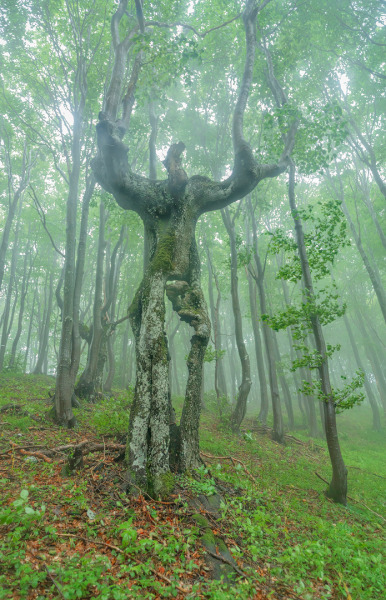


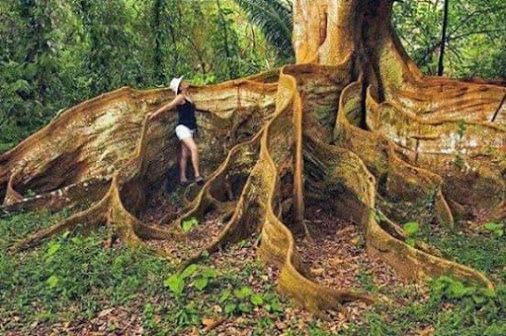









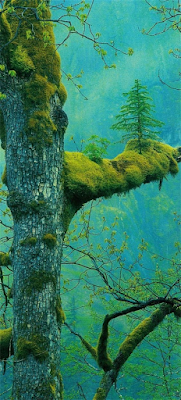

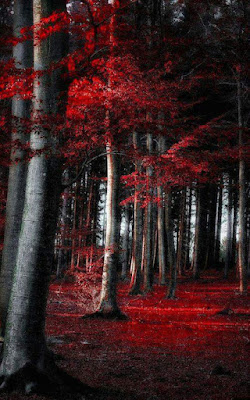

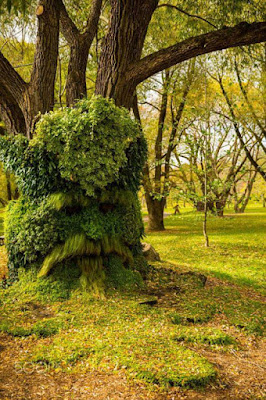































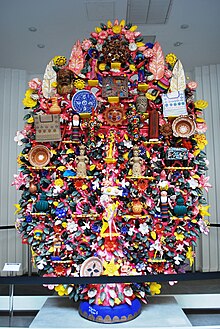
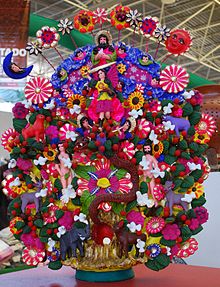
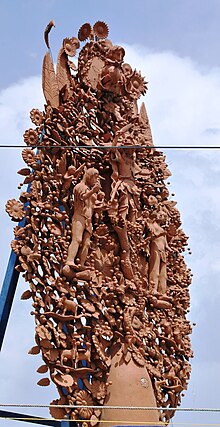









No comments:
Post a Comment